Introduction: The Hague's Premier Painter
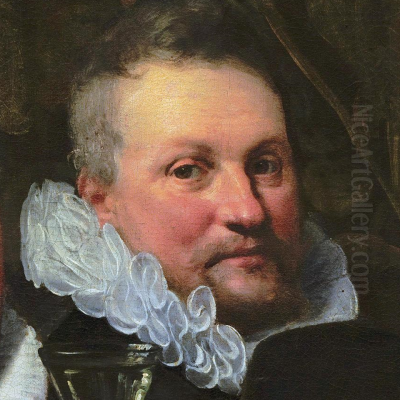
The Dutch Golden Age, spanning roughly the 17th century, was a period of extraordinary artistic flourishing in the Netherlands. While Amsterdam pulsed with the energy of commerce and artists like Rembrandt van Rijn captured its soul, The Hague, as the seat of government and the court of the Princes of Orange, cultivated its own distinct artistic milieu. Central to this environment was Jan Anthonisz van Ravesteyn (circa 1572 – buried 21 June 1657), a Dutch painter who became one of the most sought-after portraitists of his time, meticulously documenting the faces of the Republic's elite. His long and productive career established him as a cornerstone of portrait painting in The Hague, leaving behind a legacy of finely crafted images that offer invaluable insights into the society and personalities of his era.
Early Life and Uncertain Training
Jan Anthonisz van Ravesteyn was likely born in The Hague around 1572, although the exact date remains unknown. Details about his earliest years and artistic training are scarce and subject to some debate among art historians. For many years, it was commonly assumed that he was a pupil of the renowned Delft portrait painter Michiel Jansz. van Mierevelt (1567–1641). Mierevelt ran a highly successful workshop and was himself a dominant force in portraiture, known for his polished technique and prolific output.
However, this direct tutelage under Mierevelt has been questioned. Close examination of Ravesteyn's earliest known works reveals stylistic differences from Mierevelt's established manner. Ravesteyn's early portraits sometimes exhibit a slightly cooler palette and a different handling of light and texture compared to the typical Mierevelt production. This has led some scholars to suggest that while Ravesteyn was undoubtedly aware of and influenced by Mierevelt's success and style – as any aspiring portraitist in the region would be – he may not have formally trained in his workshop. It's possible he was self-taught to a degree, or perhaps studied with a less prominent master whose identity is now lost. Regardless of his specific master, the artistic environment of Delft and The Hague, with Mierevelt as a towering figure, certainly shaped his development.
Establishing a Career in The Hague
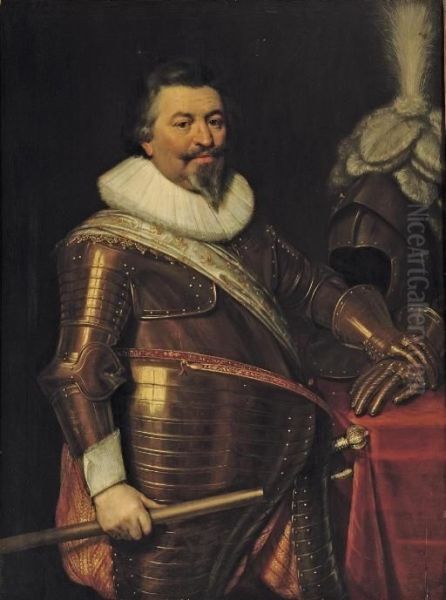
By 1597, Jan van Ravesteyn was documented as living and working in The Hague. A significant milestone occurred the following year, in 1598, when he was accepted as a master into the Guild of Saint Luke of The Hague. Membership in the guild was essential for any artist wishing to practice independently, take on pupils, and sell their work legally within the city. This marks the official beginning of his independent career.
The Hague, as the administrative heart of the Dutch Republic and the residence of the Stadtholder (the Prince of Orange), provided fertile ground for a portrait specialist. Government officials, diplomats, high-ranking military officers, and members of the nobility associated with the court all required portraits to signify their status, commemorate their achievements, or simply leave a likeness for posterity. Ravesteyn quickly tapped into this demand, establishing a reputation for reliable, high-quality portraiture. His workshop appears to have become productive early on, suggesting he rapidly gained commissions and recognition within the city's influential circles.
Artistic Style: Detail, Formality, and Character
Jan van Ravesteyn developed a distinct and highly recognizable style characterized by meticulous detail, careful rendering of textures, and a certain formal elegance. He excelled at capturing the specific materials of his sitters' attire – the intricate lace of ruffs and cuffs, the sheen of silk and satin, the gleam of polished armor, and the richness of velvet and fur. This attention to detail was highly valued by his clientele, as clothing and accessories were crucial indicators of wealth and social standing in 17th-century Dutch society.
His compositions are typically straightforward, often featuring bust-length or three-quarter-length poses against plain, dark backgrounds. This focuses the viewer's attention entirely on the sitter. While sometimes criticized for a degree of stiffness or formality, particularly when compared to the more dynamic or psychologically intense portraits by contemporaries like Frans Hals (c. 1582–1666) in Haarlem or Rembrandt in Amsterdam, Ravesteyn's work possesses a quiet dignity and presence. He used light effectively, usually employing a clear, relatively even illumination that models the features precisely without resorting to dramatic chiaroscuro.
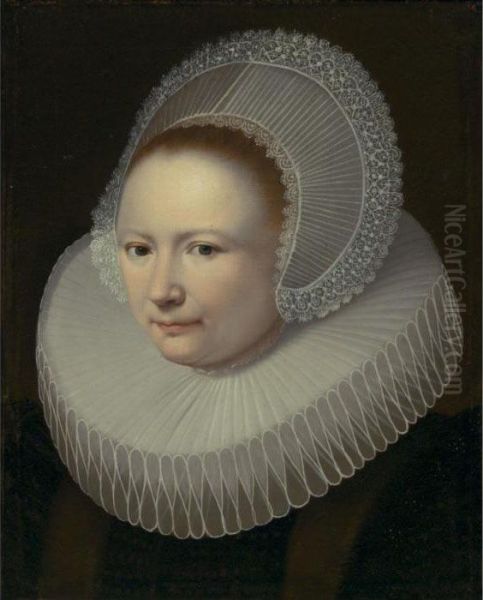
Ravesteyn's ability to capture a convincing likeness was paramount. His portraits convey a strong sense of the individual's physical appearance. While perhaps not delving into the profound psychological depths explored by Rembrandt, his faces are far from generic masks. They often reveal subtle hints of personality – a glint of determination in the eyes of an officer, a sense of quiet reserve in a noblewoman, or the assured bearing of a magistrate. His style represented a solid, respectable, and highly skilled approach to portraiture that perfectly suited the tastes of the courtly and official circles in The Hague. His work shows an affinity with the slightly earlier traditions of Netherlandish portraiture, perhaps echoing the precision found in artists like Anthonis Mor (1517–1576).
Patrons and Prominent Commissions
Throughout his long career, Ravesteyn served a distinguished clientele. He received numerous commissions from members and associates of the House of Orange-Nassau, the de facto ruling dynasty of the Dutch Republic. While perhaps not holding an official title as court painter in the way Gerard van Honthorst (1592–1656) later would, Ravesteyn was frequently called upon to paint portraits of key figures. Sitters included members of the extensive Nassau family and individuals connected to the court of Frederick Henry, Prince of Orange (1584–1647), and his wife Amalia van Solms-Braunfels (1602–1675).
Beyond the court, Ravesteyn was the go-to painter for high-ranking military officers. The Dutch Republic was frequently involved in conflicts, particularly the Eighty Years' War against Spain, and military prowess was highly esteemed. Ravesteyn painted numerous individual portraits of officers, often depicted in gleaming armor, sometimes holding batons of command or resting a hand on a helmet. These portraits project an image of strength, discipline, and authority.
He also undertook important civic commissions. Notably, he painted group portraits of the Hague civic guard (schutterij). These large-scale works, known as schutterstukken, were a distinctively Dutch genre. Ravesteyn's contributions include The Magistrates of The Hague Receiving Fifteen Officers of the St Sebastian Civic Guard (1618), now housed in the Haags Historisch Museum. These complex compositions required considerable skill in arranging multiple figures naturally while ensuring each individual was clearly recognizable. His success with such commissions further solidified his position as the leading painter in The Hague. Wealthy burghers and local officials also frequented his studio.
Representative Works and Collections
Jan van Ravesteyn's oeuvre is substantial, with many works surviving in museums and private collections worldwide. Several key examples illustrate his style and typical subjects:
Portraits of Officers: A notable example is the Portrait of an Officer (c. 1611-1612), held by the Bavarian Army Museum in Ingolstadt, Germany. This work depicts a man in elaborate armor adorned with a striking orange sash and plume, likely signifying allegiance to the House of Orange. The meticulous rendering of the metal, the determined gaze of the sitter, and the overall martial bearing are characteristic of Ravesteyn's military portraits.
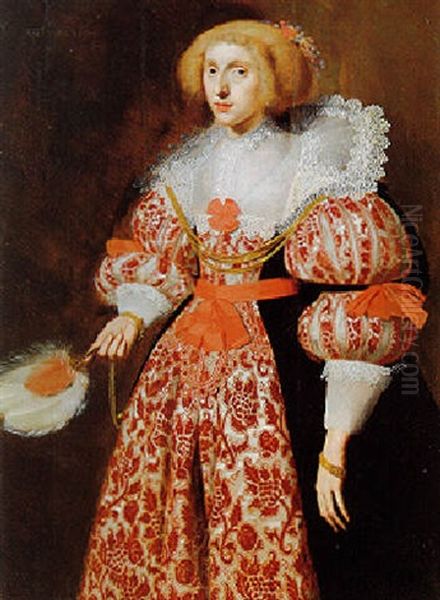
Female Portraits: Ravesteyn painted numerous portraits of women from the Dutch elite. Two examples in the Metropolitan Museum of Art, New York, are Portrait of a Woman (1636) and Portrait of a Woman with Red Hair (1631). These works showcase his skill in depicting elaborate costumes, particularly the large millstone ruffs fashionable in the period, and the fine details of jewelry and lace caps. The sitters are presented with a sense of decorum and status.
Civic and Official Portraits: The portrait of Reynier Pauw van Nieuwerkerck (1633), located in the Dordrechts Museum, depicts a member of an influential Amsterdam family, showcasing Ravesteyn's reach beyond The Hague's immediate circles. His portrait of the jurist Rombout Hogerbeets (c. 1625-1626), known through later prints by artists like Matthijs Pool (1670-1732), demonstrates his role in immortalizing important figures in Dutch public life.
Royal and Noble Sitters: His Portrait of Henry Frederick, Prince of Palatine (1623), housed at Doddington Hall in the UK, is an example of his work for European nobility connected to the Dutch court (Henry Frederick was the eldest son of Elizabeth Stuart, the "Winter Queen," who lived in exile in The Hague). The Mauritshuis Royal Picture Gallery in The Hague holds several works by Ravesteyn, fittingly preserving the legacy of a painter so closely associated with the city.
Workshop Attributions: Some works, like the Portrait of Nicolaes Smeling (dated around 1660, after Ravesteyn's death), are considered products of his workshop, indicating the continued operation and influence of his style even towards the end of his life and immediately after. The existence of such works points to a well-organized studio capable of handling numerous commissions.
The Ravesteyn Workshop and Pupils
Given the volume and consistent quality of his output over several decades, it is certain that Jan van Ravesteyn operated a successful workshop in The Hague. He would have employed assistants and trained pupils to help with tasks ranging from preparing canvases and grinding pigments to painting backgrounds, drapery, and potentially producing copies or variants of successful portraits.
His own family was involved in the arts; his brother, Anthony van Ravesteyn (fl. 1614–1669), was primarily known as a glass painter but may have collaborated or been associated with Jan's studio. Jan himself had several documented pupils who went on to establish their own careers.
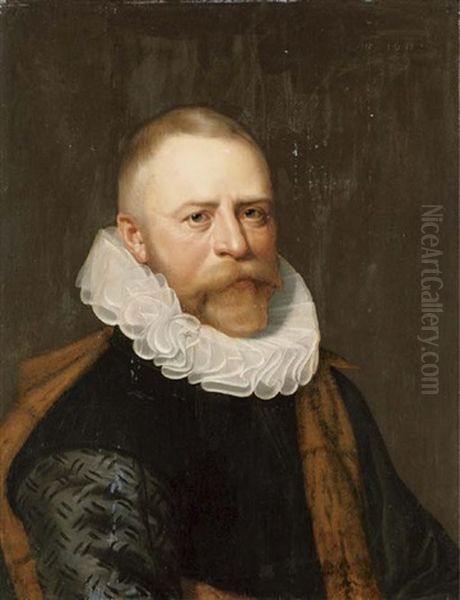
The most significant of these was undoubtedly Adriaen Hanneman (c. 1603–1671). Hanneman trained with Ravesteyn before traveling to England, where he spent around sixteen years and absorbed the elegant, courtly style of Sir Anthony van Dyck (1599–1641). Upon returning to The Hague around 1637, Hanneman became a highly successful portraitist in his own right, skillfully blending his Ravesteyn training with Van Dyckian flair. He became a rival to his former master but also a collaborator in artistic endeavors. Other documented pupils or workshop associates include Dirck Abrahamsz. (dates unknown) and Leendert Barthouts (c. 1610–after 1660). The workshop system was crucial for disseminating Ravesteyn's style and meeting the high demand for his work.
Founding the Confrerie Pictura
In his later years, Ravesteyn played a key role in a significant development within The Hague's artistic community. For centuries, painters, sculptors, and craftsmen had been organized under the Guild of Saint Luke. However, by the mid-17th century, tensions arose. Many prominent painters felt the guild structure, which included house painters and other artisans, did not adequately represent their interests or status as fine artists. They sought greater autonomy and recognition.
In 1656, a group of dissatisfied artists, including many of the city's leading painters, broke away from the Guild of Saint Luke to establish a new, exclusive society called the Confrerie Pictura (Brotherhood of Painters). Jan van Ravesteyn, by then an elderly and highly respected figure, was among the founders. His participation lent considerable weight and prestige to the new organization. Adriaen Hanneman was also a driving force behind its creation. The founding of the Confrerie Pictura marked an important step in the professionalization and elevation of the status of painters in The Hague.
Later Life, Death, and Legacy
Jan Anthonisz van Ravesteyn remained active as a painter well into his old age, a testament to his enduring skill and reputation. He continued to receive commissions and participate in the artistic life of The Hague. He died in 1657 and was buried in the Grote Kerk (Great Church) in The Hague on June 21st of that year.
His legacy is multifaceted. Primarily, he left behind a vast visual record of the Dutch elite during a formative period of the Republic. His portraits are invaluable historical documents, offering insights into the fashion, social hierarchy, and personalities of the time. His meticulous rendering of costume and armor provides crucial information for historians of dress and material culture.
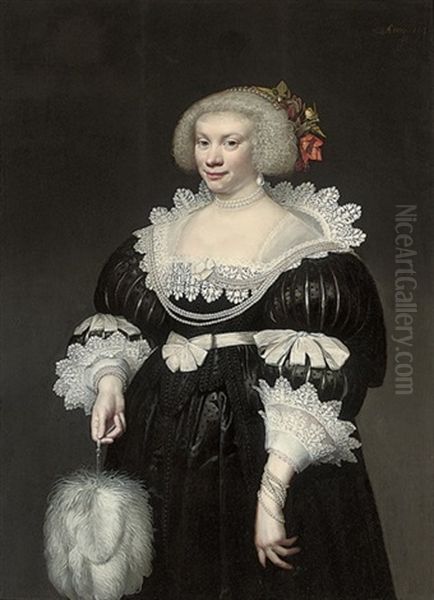
Artistically, Ravesteyn established and maintained a high standard for portraiture in The Hague for over half a century. While perhaps less innovative than Rembrandt or Hals, his consistent quality, reliable likenesses, and dignified style perfectly met the needs of his clientele. He defined a specific "Hague style" of portraiture – formal, detailed, and elegant – that influenced generations of painters in the city, most notably through his pupil Adriaen Hanneman. His influence can be seen as representing a solid, traditional strand within the diverse tapestry of Dutch Golden Age art, contrasting with the more dynamic or emotionally charged styles found elsewhere. Even modern artists like Peter Paone and Dimitris Ladopoulos have referenced his work, indicating its enduring presence in art historical consciousness. Other contemporaries like Cornelis Janssens van Ceulen (1593-1661), who worked both in England and the Netherlands, or Wybrand de Geest (1592-c. 1661) in Friesland, offer points of comparison for the varied approaches to portraiture during this rich period.
Conclusion: A Defining Figure of The Hague's Golden Age
Jan Anthonisz van Ravesteyn stands as a pivotal figure in the art of the Dutch Golden Age, particularly within the context of The Hague. As a master portraitist, he skillfully captured the likenesses of the men and women who shaped the Dutch Republic – from members of the House of Orange and military commanders to civic officials and wealthy citizens. His meticulous technique, attention to detail, and the formal dignity of his compositions perfectly suited the tastes of the courtly and administrative capital. Through his prolific output, his influential workshop, and his role in founding the Confrerie Pictura, Ravesteyn not only documented his era but also significantly shaped the artistic landscape of The Hague for decades. His works remain essential references for understanding the society, culture, and art of the Netherlands during its most celebrated century.